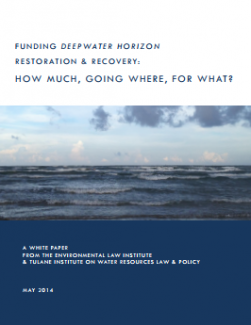
Recovering and restoring the Gulf of Mexico from the injuries caused by the disaster is an astoundingly complex undertaking. The processes that have been initiated to spur the assessment and treatment of various types of harm at various scales of action are accordingly complex. While it is unknown how much will ultimately be spent to recover the Gulf of Mexico from Deepwater Horizon, restoration and recovery funds are steadily accumulating from the parties responsible for the disaster. The monies result from mandates and penalties under numerous statutes, including the Oil Pollution Act, Clean Water Act, and Migratory Bird Treaty Act. Who receives the funds and how they must be spent is determined both by the overarching statute and by the manner of resolution.
So far, we know a number of different entities will receive funds. We don’t know if additional entities will be added to the list or the total amount each will receive when all is said and done. Perhaps most importantly, because the funds are coming through different channels and carrying varying obligations, we also don’t know whether or how spending will be coordinated. This white paper focuses on the funds that are being distributed to governmental and nongovernmental entities as a result of the Deepwater Horizon disaster for regional restoration and recovery activities. It provides background information on the restoration and recovery funds that have been identified and earmarked to date, including funds that will be flowing through the:
- Oil Spill Liability Trust Fund (OSLTF);
- North American Wetlands Conservation Fund (NAWCF);
- National Fish and Wildlife Foundation (NFWF);
- National Academy of Sciences (NAS);
- Restoration Trust Fund, created by the Resources and Ecosystem Sustainability, Tourist Opportunities, and Revived Economies of the Gulf Coast States Act of 2012 (the “RESTORE Act”); and
- Natural Resource Damage Assessment (NRDA).
After providing background on each of these processes, the paper explores the bigger questions of how these myriad processes fit together and their potential long-term impacts.